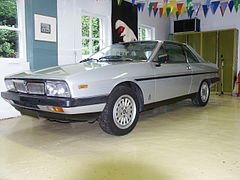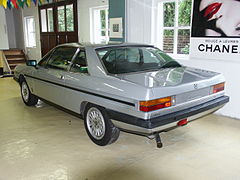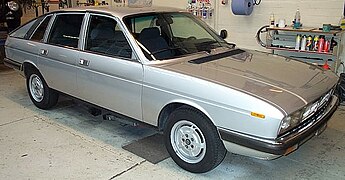
The Ford Laser is a compact car, originally a subcompact car in the first three generations, which was sold by Ford in Asia, Oceania, and parts of South America and Africa. It has generally been available as a sedan or hatchback, although convertible, wagon and pick-up versions have also been available in different markets. The sedan, and briefly station wagon, versions were badged Ford Meteor in Australia between 1981 and 1987. The Ford Meteor name was also used in South Africa.

The Fiat Punto is a supermini car (B-segment) produced by the Italian manufacturer Fiat from 1993 to 2018, spanning over three generations. The third generation of the car was marketed between 2005 and 2009 as the Grande Punto, and between 2009 and 2012 as the Punto Evo, until the single-word Punto name was reintroduced. As of May 2013, nearly nine million units had been sold globally.

The Lancia Thema is an executive car produced by the Italian automaker Lancia between 1984 and 1994, and one of four cars to share the Type Four platform alongside the Alfa Romeo 164, Fiat Croma and Saab 9000. The Thema was first shown in Turin Motor Show in 1984.

The Autozam Revue is a subcompact car that was sold by Autozam, introduced in 1990. The demise of that marque led to the cars being renamed as the Mazda Revue in some markets. The car was also sold in many export markets as the Mazda 121, where it replaced the previous 121 that had been based on the first-generation Ford Festiva.
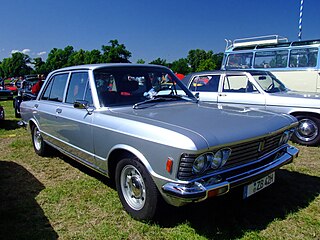
The Fiat 130 is a large six cylinder executive car produced by Italian car manufacturer Fiat from 1969 to 1977. It was available as a 4-door saloon and as a 2-door coupé.

The Lancia Fulvia is a car produced by Lancia between 1963 and 1976. Named after Via Fulvia, the Roman road leading from Tortona to Turin, it was introduced at the Geneva Motor Show in 1963 and manufactured in three variants: Berlina 4-door saloon, 2-door Coupé, and Sport, an alternative fastback coupé designed and built by Zagato on the Coupé floorpan.

The Lancia Flavia is an executive car produced by Lancia in Italy from 1961 to 1971. Production continued as the Lancia 2000 from 1971 to 1975.

The Lancia Flat-4 engine is an aluminum, pushrod, and later overhead camshaft, flat-four (boxer) engine made by Lancia, initially for the Flavia, from 1960 through 1984. Though it was designed as a pushrod engine, it was advanced for the time. The pushrod version of the Lancia boxer was only ever used in the Flavia, and its derivatives including the Lancia 2000. In 1976, a new overhead cam engine based on a similar layout was designed and brought into production in 2 and 2.5-litre displacements for the Gamma.

The Lancia Beta was an entry-level luxury car produced by Italian car manufacturer Lancia from 1972 to 1984. It was the first new model introduced by Lancia after it had been taken over by Fiat in 1969.

The Fiat 124 Sport Coupé is a two-door, four-seater notchback coupé produced by the Italian automaker Fiat in three generations between 1967 and 1975. It was based on the Fiat 124 saloon.

The Lancia Dedra is a compact executive car produced by the Italian automaker Lancia from 1989 to 1999. It was initially designed to support, and later to replace, the Prisma that, six years after its launch, was having difficulty remaining competitive with its latest opponents. It can be considered as the saloon version of the second generation Delta, that was launched four years later, in 1993.

The Alfa Romeo 1750 Berlina and Alfa Romeo 2000 Berlina were executive cars produced by Italian car manufacturer Alfa Romeo from 1968 to 1977. Berlina is the Italian term for a saloon car. Both cars had Alfa Romeo twin cam inline-four engines; the 1.8-litre 1750 Berlina was made between 1968 and 1971, when it was phased out in favour of the improved 2.0-litre 2000 Berlina.

The Fiat 850 is a small rear-engine, rear-wheel-drive car manufactured and marketed by Italian car manufacturer Fiat from 1964 to 1973.

The Lancia Kappa or Lancia k is an executive car manufactured and marketed by Italian manufacturer Lancia from 1994–2000, with saloon, estate, and coupé variants — sharing platforms with the Alfa Romeo 166. The Kappa has a front-engine, front-drive, five passenger, left-hand drive design.

The Lancia Flaminia is a luxury car produced by Italian automaker Lancia from 1957 until 1970. It was Lancia's flagship model at that time, replacing the Aurelia. It was available throughout its lifetime as saloon, coupé and cabriolet. The Flaminia coupé and cabriolet were coachbuilt cars with bodies from several prestigious Italian coachbuilders. Four "presidential" stretched limousine Flaminias were produced by Pininfarina for use on state occasions.

The Fiat 1300 and Fiat 1500 are a series of front-engine, rear-drive automobiles manufactured and marketed by Fiat from 1961 to 1967, replacing the Fiat 1400 and Fiat 1200 coupé, spyder and cabriolet. The 1300 and 1500 were essentially identical to each other except for their engine displacement, as indicated by their model names, and were offered in sedan/saloon, station wagon, convertible and coupé body styles which shared little mechanically with the other body styles except the 1500 engine.
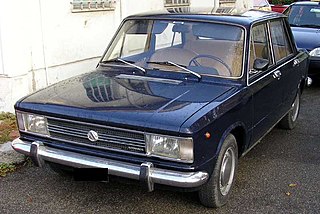
The Autobianchi A111 is a 4-door saloon family car produced from 1969 to 1972 by Italian car manufacturer Autobianchi, a subsidiary of the Fiat group. Despite rather modest dimensions, at roughly 4 metres long, it was the largest Autobianchi ever made, as the brand specialized in small cars. A modern front-wheel drive construction like the Fiat 128 launched concurrently, it was based on the revolutionary Autobianchi Primula, Fiat's first "experiment" with the transverse engine front-wheel-drive setup.

The Lancia Appia is a passenger car introduced in 1953 by Italian car manufacturer Lancia as a replacement for the Ardea, and which remained in production for ten years. The Appia was the last in a long line of Lancia production cars dating back to the Lancia Lambda to use sliding pillar front suspension. All three series produced had a 1089cc Lancia V4 engine.
The Turin Motor Show was an auto show held annually in Turin, Italy. The first official show took place between 21 and 24 April 1900, at the Castle of Valentino, becoming a permanent fixture in Turin from 1938 having shared it with Milan and Rome until that time. From 1972, the show was held biannually and in 1984, it moved into Fiat's shuttered Lingotto factory.
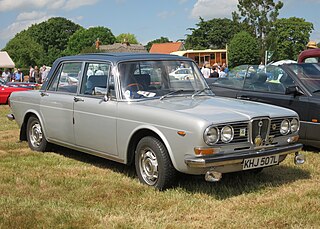
The Lancia 2000 is a series of automobiles produced by Lancia between 1971 and 1975. It was the last vehicle designed by Lancia engineers before the marque's acquisition by Fiat in 1969. The Lancia 2000 was a direct evolution of the Lancia Flavia, which it replaced.


